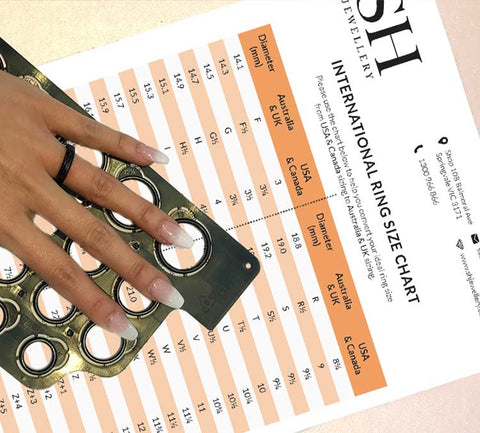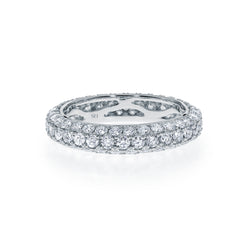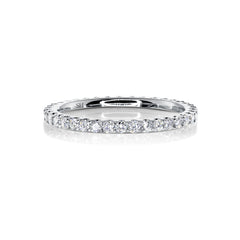Your Cheat Sheet to Diamond Engagement Ring Lingo
Use this alphabetical engagement ring guide for diamond & jewellery terminology and learn how to choose an engagement ring with confidence.
Abrasion
A tiny scratch on a diamond’s surface.
Alloy
A mixture of two or more metals designed to manipulate metal qualities like durability and produce desired colour combinations. Gold, for example, contains pure gold alloyed with other metals, such as silver, manganese, nickel, zinc and palladium.
Baguette
A long, rectangular cut diamond with 14 facets often seen in vintage-inspired rings or used as side stones to accentuate the feature diamond.
Bearded Girdle
A diamond girdle that has small chips or feather-like fractures that extend into the diamond.

Bezel-Set
A diamond setting technique that features a metal fringe gently overlapping the circumference of the diamond to secure it in place. Bezel-set diamonds are well protected from knocks, making it an ideal setting for those with active lifestyles. Its snag-resistant flat profile also makes the setting less likely to require the kind of emergency repairs associated with warped or broken prongs. Because the base of the diamond is hidden within the metal however, less light filters through the stone. To allow more light to reach the diamond, a half-bezel setting can be used, which features a break in the metal for light to reach in between (see image 3).
Blemish
A small imperfection visible on the surface of a diamond which can affect the diamond’s clarity grading.
Brilliance
Brilliance refers to the brightness of white light reflected when viewing a diamond’s crown. Brilliance is created by meticulously cutting and polishing the stone in a way that gathers light and redirects it back to the eye. Poor cutting and polishing can result in light leaking through the pavilion, which can dull the diamond’s brilliance. The cut must also feature contrast to create the on/off flashing effect of the facets in motion, which is known as scintillation. Scintillation must be present for maximum brilliance.
Carat
A unit of measurement that refers to a diamond’s weight and apparent size. A metric “carat” is equivalent to 200 milligrams. Diamond carats can be subdivided into 100 points, allowing for very precise measurements to the hundredth decimal place. It’s important to note that a diamond’s value is based on all 4Cs and not just carat size.

Channel-Set
Channel settings feature diamonds set between two vertical metal walls that create a flat profile for maximum protection. There is no metal in between the diamonds, and the metal walls slightly overlap the side of the diamonds to form a small lip that protects them from accidental knocks. With no prongs or claws, channel settings are a snag-free design that won’t catch on clothes, hair or bed sheets.
Clarity
Diamond clarity refers to the visual imperfections present on the surface and within a diamond. These imperfections are used to create a clarity grading for the diamond; the fewer and smaller the inclusions, the higher the grade and diamond price. Surface imperfections are known as blemishes, and internal flaws are known as inclusions. The majority of inclusions can’t be seen by the naked eye and therefore do not detract from the diamond’s beauty. Gemologists often refer to inclusions as “internal characteristics” rather than flaws, as it’s these small naturally formed features that make a diamond unique. If you want a diamond that is completely free from inclusions visible to the naked eye, choose clarity grade VS2 or above. The GIA Diamond Clarity Scale includes six categories and 11 diamond clarity grades ranging from I3 to Flawless.
Claw-Set
Also known as prong-set diamonds, claw settings feature two or more metal prongs that wrap around the crown of the diamond. Once the diamond is placed inside the basket-like prong formation, the prongs are bent to tightly secure the stone in place. Rounded prongs are the most common type of SH claw setting, however we also offer more decorative designs like square prongs, heart prongs, pointed prongs and arrow-shaped prongs.

Cleavage
In the gemstone world, cleavage refers to the propensity of a mineral to split along defined planes when subjected to stress. Minerals with perfect cleavage produce a full, smooth plane where the crystal broke, without leaving any rough surfaces. In gemstones with perfect cleavage, facets must be cut transverse to the cleavage planes so the gem is less vulnerable to breakage.
Colour
The presence of colour in a diamond can reduce its value. A chemically pure and structurally perfect diamond has no hue, so the less colour, the more desirable the diamond. By comparing diamonds under controlled lighting and precise viewing conditions, diamond graders can consistently measure the degree of colourlessness in a diamond using the GIA’s D-to-Z diamond colour grading scale. Colour distinctions can be so subtle that they are invisible to the untrained eye, making it important to purchase only GIA certified diamonds.
Cushion-Cut
Similar in appearance to a pillow, cushion cuts combine a square cut with gently rounded corners. They are also available in slightly rectangular shapes. While often less brilliant than round brilliant cuts, cushion-shaped diamonds are famous for their fire displays.
Crown
The crown of a diamond is the section above the girdle (the widest part of the diamond) and the table (the flat surface area on top). The crown angle is usually between 32 to 36 degrees

Culet
The small area at the bottom of the diamond's pavilion where the facets of the pavilion meet. It can be a point or a very small facet that sits parallel to the table. When a flat culet is present it adds an additional facet to the diamond’s total, whereas a pointed culet does not.

Cut
The GIA Cut Scale is used to determine how diamonds interact with light to create desirable effects like brightness, fire and scintillation. Of all the 4Cs, Cut is the most complex and technically difficult to evaluate, taking into account the diamond’s design and craftsmanship, including weight relative to diameter, girdle thickness (which determines durability), facet symmetry, and facet polish quality to produce a GIA certified grade ranging from Excellent to Poor.
Depth
Depth represents the diamond’s height measured in millimeters from its point or culet to its table. The ideal depth varies between cuts and can have a considerable effect on the diamond’s appearance and value.

Dispersion
Also referred to as fire, dispersion describes the separation of white light into different colours, creating a rainbow effect.
Emerald-Cut
Emerald-cut diamonds are rectangular or square in shape featuring 57 facets and cut-off corners with a large surface table. Emerald cuts are famous for their ‘Hall of Mirrors’ effect, which causes flashes of light generated by straight, linear facets.



Eternity Ring
Eternity rings feature diamonds or gemstones set around the entire perimeter of the band to symbolise never-ending love. Also known as Infinity Rings.
Facet

Fancy
Feather
Fire
Flaw
Floating Diamonds
Four Cs (4Cs)
Halo
Hardness
A diamond’s ability to resist scratches. Diamonds rate 10 on Mohs Mineral Hardness Scale, making them 40 times stronger than the mineral in category 9 (Corundum, which can make rubies and sapphires).
Heart-Cut
Based on the popular round brilliant cut diamond, heart cut diamonds contain between 56-58 facets, with six to eight facets forming the diamond’s pavilion.
Hypoallergenic
In reference to engagement rings and wedding ring metals, hypoallergenic means the metal alloy used is relatively unlikely to cause an allergic reaction. Yellow gold is the most hypoallergenic of gold metals, meaning it’s least likely to cause allergic reactions in people with sensitive skin.
Inclusions
Infinity Ring
Karat
A karat (K) is a unit of measurement that indicates the proportion of gold in an alloy out of 24 parts. For example, 18K gold is 18 out of 24 parts gold - the rest is a mixture of other metals designed to improve durability and achieve a desired colour.
Marquise-Cut
Also known as Navette diamonds (French for “little ship”), Marquise cuts are dramatic eye-shaped diamonds with pointy ends admired for their ability to make fingers appear thinner and longer.
Modern
Modern engagement rings are a unique category that don’t conform to strict and consistent design rules. Lavish in nature, metal visibility is usually low, with diamonds of various carats and cuts covering most of the band. Modern engagement rings feature a variety of diamond shapes, arrangements and setting techniques to produce spectacular engagement rings in a league of their own.
Mohs Hardness Scale
The Mohs Hardness Scale is a scale used to measure the hardness of minerals and natural materials. It was developed by Friedrich Mohs, a German mineralogist, in 1812. The scale is based on the ability of one material to scratch another, with each mineral on the scale assigned a hardness value from 1 (softest) to 10 (hardest). Diamond is the hardest mineral on the Mohs scale, with a hardness of 10.
Oval-Cut
Pavé-Set
Pronounced ‘pah-vay’ from the French word ‘to pave’, this diamond setting technique involves placing the stones low and close together using small metal beads or prongs that are barely visible beneath the diamonds’ glow. White gold is a popular choice for pavé-set rings, as the metal blends well, allowing the diamonds to take centre stage.
Pavilion
The bottom half of the diamond typically hidden within the ring setting. Although mostly hidden, the pavilion plays a significant role in the diamond’s appearance, as its carefully cut facets help light to enter, bounce and reflect through the stone, improving its fire and brilliance. The three areas of the pavilion are the girdle, pavilion facets and culet.

Pear-Cut
Also known as teardrops, pear-cut diamonds combine the best of round and marquise diamonds to produce gently curved shoulders and wings that taper to a striking point, traditionally worn facing away from the body.
Platinum
The rarest type of engagement ring metals symbolising solidarity and prestige. It is naturally metallic in appearance, which like white gold, brilliantly enhances a diamond’s sparkle. Platinum is about 20% denser than white gold, requiring more of it to produce the same style of ring, which results in a heavier, more substantial feel when worn.
Princess-Cut
A type of diamond cut combining the brilliance of a round brilliant cut with 90 degree corners that create a square shape when viewed from above and inverted pyramids when viewed from the side. The number of facets and the faceting arrangement of princess cut diamonds can vary widely.
Prong Set / Prongs
Radiance
Another word to describe the sparkle of a diamond caused by refracting and reflecting light.
Radiant-Cut
Radiant cut diamonds combine the finest elements of a round brilliant cut with an emerald cut. They have a complete brilliant cut facet pattern applied to both the crown and pavilion, with cropped corners offering excellent protection from chipping.
Ring Sizer Tool

Rose Gold
Rough Diamond
Round Brilliant Cut Diamond
Scintillation (a.k.a Sparkle)
Shank

Solitaire
Table
The large, flat facet on a diamond’s surface that you see when you look at the diamond from above. The table is the largest facet on a diamond and plays a significant role in determining how brilliant a diamond is.

Tension Set
Three-Stone
Also known as trilogy rings, three-stone engagement rings feature three stones said to represent a couple’s past, present & future, or friendship, love & fidelity. Two side diamonds flank a higher-carat centre stone typically of the same cut, though different cuts can also create a beautifully balanced combination. Additional diamonds can be set around the band, or a simple gold band may be preferable to highlight a heavy-carat centre stone.
Timeless
A word used to describe an enduring design that stands the test of time. May also refer to the Timeless engagement rings category that features a centre diamond flanked by smaller side diamonds for added shine and depth of design.
Trilogy Ring
Two-Tone
When two different metals appear in the same ring. This is not common practice for traditional engagement rings and more often seen in men’s wedding bands.



White Gold
Like yellow gold, white gold contains pure gold alloyed with other metals, such as silver, manganese, nickel, zinc and palladium. White gold engagement rings are usually plated with rhodium (a platinum group metal applied to reduce scratching and tarnishing), which produces a chrome-like reflective finish. This makes white gold a popular choice for engagement rings due to its ability to intensify a diamonds’ sparkle. Despite being harder and more scratch resistant than yellow gold, the rhodium plating wears over time and requires re-application every 1-3 years. Engagement ring rhodium plating services are performed instore at SH Jewellery by Master Jewellers usually as a next day service.
Yellow Gold
The more traditional choice of engagement ring metal. Yellow gold engagement rings contain a combination of pure gold and other metals like copper, brass, zinc and silver, which are added to make the gold stronger. The colour of yellow gold engagement rings differs depending on the karat (i.e. the percentage of other metals present). 18K produces a richer, more vibrant yellow, while lower karats offer a paler shade. The warm patina of yellow gold is due to the red influence of copper and the green caused by silver. Yellow gold is the most hypoallergenic of gold metals, making it ideal for sensitive skin types. It is not as durable as white gold, so when comparing rings of the same karat, yellow gold will wear faster than white gold. For those with active lifestyles or physical occupations, white gold engagement rings may therefore be a more suitable option.
Can’t find what you’re looking for?
Our team of Engagement Ring Specialists can answer all your questions about how to buy an engagement ring. Schedule a complimentary phone consultation, or visit our Springvale Showroom to experience the famous SH customer experience instore and discover the best engagement rings to buy with diamonds 3-4 grades higher than industry standards and 7-8 grades higher than retail chain stores.

































































